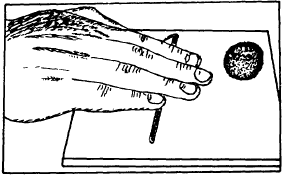|
Steps in the test procedure are as follows: 1. Squeeze and form the 8-g test sample into an
oval-shaped mass. Roll this mass between the

Figure 15-38.-Roll or thread test.
fingers and the test board (fig. 15-38) with just enough
pressure to roll the mass into a thread of uniform
diameter throughout its length. The rate of
rolling should be between 80 and 90 strokes a
minute, considering a stroke to be one complete motion
of the hand forward from and back to the
starting point.
2. When the diameter of the thread has been reduced
to 1/8 in., break the thread into six or eight
pieces (fig. 15-39). Squeeze the pieces together
between the thumbs and fingers of both hands
into a uniform mass roughly oval in shape, and
again roll out into a thread. Continue this alternate
rolling to a thread 1/8 in. in diameter, breaking,
combining together, and rerolling. Do this
until the thread crumbles under the pressure required
for rolling and the soil can no longer be rolled
into a thread. The crumbling may occur when
the diameter of the thread is still greater than 1/8
in. This is considered a satisfactory end point, provided
the soil has previously been rolled into a
1/8-in. thread at least once.
3. Gather the portions of the crumbled soil together,
place it in the moisture content can, and determine
the water content from the difference in
weight before and after you oven-dry it.
4. Repeat the process on at least two additional specimens.
All three tests should agree within
1 percent. The plastic limit is
simply the determined water content.
|


|

